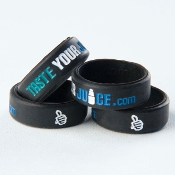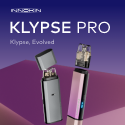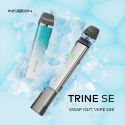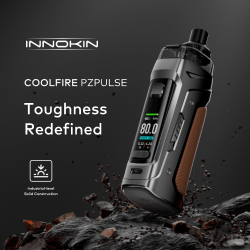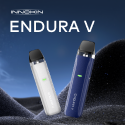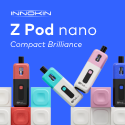I would like to personally welcome Battery Mooch to TasteYourJuice.com.
“Mooch” is well known in the industry as the “battery guy” and is quite popular on the ECF. I’ve worked with Mooch several times in the background and he’s always been quite helpful and knowledgeable in answering my questions.
Although I have some experience with battery testing, Mooch has all the experience I lack so I though it a good fit to offer him his own page here on TasteYourJuice.com.
If you look to the left, you’ll see the new Battery Mooch page under Information/Resources. His first article can be found there as well.
WELCOME MY FRIEND!
Who is Battery Mooch?
My name is John Muchow, some of you may know me as Mooch on ECF and FB and Mooch315
on ECR. I have been vaping since April, 2015 and haven’t smoked once since I
started!I was born and raised in New York City and still live there now. Since 1992 I have
been designing and building electronic devices for a large number of clients. My
first products were camera remote-control systems for sports photographers. As these
systems, and other devices, transitioned from wired to wireless the performance of
the batteries they used was very important as there was no way to replace them
during use. This led to me doing more and more battery testing and developing the
electronics to charge, test, and protect them.As battery technology advanced, from NiCd to NiMH to Li-Ion and now
ultracapacitor/Li-Ion hybrids, the devices I built and the battery testing I did
advanced along with them. I started specializing in power management electronics;
battery chargers, energy harvesters (for charging from heat, light, or
vibration/movement), power supplies, battery analyzers, electronic loads for battery
discharging, and battery management/protection systems. This is the work I still do
today.My clients have included the US Army, National Geographic, Sports Illustrated,
Eastman Kodak Company, and hundreds of other companies from large to small. Part of
the work I’ve done for a lot of my clients has been battery testing. Sometimes they
want to recommend a good battery to their customers. Other times they’re batteries I
have chosen to combine with my electronics to form a complete, protected power
source for them to incorporate into their products.Depending on my client’s requirements this testing can take up to several weeks to
complete. I use a subset of these tests when evaluating the batteries we use when
vaping. This includes continuous-current tests to establish the battery’s true (and
safe) ratings. They also help to determine if there’s any risk of venting if one of
our mods autofires or a mechanical mod’s button is accidentally pressed. The
pulse-current tests measure the degree of voltage sag we would see when vaping at
different current levels. Both types of tests are done the same way for every set of
batteries I test.This consistency in the testing allows for direct comparison of the performance of
different batteries even if the pulse discharging I do doesn’t match the way you
vape.Safety is my number one priority. While I often test at discharge current levels
that can result in unsafe battery temperatures, this is the only way to figure out
what a battery’s true and safe ratings are. No battery is totally safe but we can
certainly avoid taking unnecessary risks.My blog at ECF has the results of all my testing and a few articles on batteries,
battery safety, etc.:https://www.e-cigarette-forum.com/forum/blogs/mooch.256958/
I have also listed the equipment I use and the steps I follow when testing. This
allows anyone to replicate my tests if they want to:https://www.e-cigarette-forum.com/forum/blog-entry/my-cell-testing-equipment-and-setup.7431/
https://www.e-cigarette-forum.com/forum/blog-entry/whats-done-for-each-cell-test.7433/
My battery test results offer you a resource you can use when choosing a battery
that will not only be safer for the way you vape but will also give you great
performance.I’m looking forward to contributing to TasteYourJuice.com and I want to thank
PBusardo for the opportunity to help spread the word on exaggerated battery ratings
and battery safety!Mooch
Latest Battery Updates
A BATTERY MOOCH POST: Efest Metallic Purple 35A 4200mAh 26650 Bench Test Results…just a 23A battery but 4300mAh
Bottom Line: This new Efest uses a translucent wrap that gives it a metallic look. It tested as a 23A 4300mAh cell that is identical in appearance and performance to the Basen and Brillipower 4500mAh cells. When run at its 35A continuous rating it gets hot enough to boil water. This Efest still has the useless “pulse” rating in large lettering on the wrap but does list both the continuous and pulse current ratings. Unfortunately, the ratings are exaggerated. But because it uses the same cell as the 4500mAh Basen’s and Brillipower’s, it is one of the better performing 26650’s. As all of the new Efests have this translucent purple wrap I suspect that this cell will replace both the solid purple and the green 4200mAh cells..
Test results, discharge graph, photos: https://www.e-cigarette-forum.com/forum/threads/efest-metallic-purple-35a-4200mah-26650-bench-test-results-just-a-23a-battery-but-4300mah.747579/
All my test results to date: https://www.e-cigarette-forum.com/forum/blog-entry/list-of-battery-tests.7436/
18650 current ratings and safety grades: https://www.e-cigarette-forum.com/forum/blog-entry/18650-safety-grades-picking-a-safe-battery-to-vape-with.7447
A BATTERY MOOCH POST: Tesiyi 40A 2600mAh 18650 Bench Retest Results…changed cells, a very good 25A/2500mAh battery
Bottom Line: In my previous tests I rated this ICR Tesiyi cell as decent, but very overrated at 25A/2300mAh. They’ve changed cells but it is still overrated. It’s now a 25A/2500mAh ICR cell but the wrap has not been changed in any way to indicate that the cell was changed. They have also switched from a double-layer wrap to a single one. In addition, Tesiyi has still not updated the wraps to indicate continuous/pulse ratings as they said they would months ago. If Efest can start doing this, with accurate ratings, then I would fully expect the other companies to be able to do so too.
All this aside, this is a good 25A ICR cell with good capacity and the classic flatter discharge curve that provides a more consistent vaping experience when using a mechanical/unregulated mod. It delivers more capacity down to 3.2V than the Samsung 25R and hits harder than the VTC4 at higher current levels.
Test results, discharge graph, photos: https://www.e-cigarette-forum.com/forum/threads/tesiyi-40a-2600mah-18650-bench-retest-results-changed-cells-a-very-good-25a-2500mah.747105/
All my test results to date: https://www.e-cigarette-forum.com/forum/blog-entry/list-of-battery-tests.7436/
A BATTERY MOOCH POST: Sony VTC5A 2500mAh 18650 Bench Test Results…a fantastic 25A battery!
Bottom Line: The Sony VTC5A is a top-performing 25A 2500mAh battery. It runs at a higher voltage than the Aspire 1800mAh, VTC4/5, 25R, and HD2C and runs for almost as long as the VTC5. I want to do some more comparisons against other cells but this is probably one of the top three best 18650’s.
Test results, discharge graph, photos: https://www.e-cigarette-forum.com/forum/threads/sony-vtc5a-2500mah-18650-bench-test-results-a-fantastic-25a-battery.746719/
A BATTERY MOOCH POST: Efest Metallic Purple 20A 2900mAh 18650 Bench Test Results…accurately rated 20A, a lower grade HG2?
Bottom Line: This new Efest is accurately rated at 20A and 2900mAh and seems to rewrap a lower grade LG HG2. Its appearance is identical to the HG2 but its voltage is a bit lower and it has about 100mAh less capacity. This does not mean it’s less safe to use! It’s just a performance change and this Efest is accurately rated at 20A 2900mAh. This Efest still has the useless “pulse” rating in large lettering on the wrap but does list both the continuous and pulse ratings, a welcome change for Efest. These new metallic purple wrap 18650’s ship with a plastic battery case for each pair of batteries.
Test results, discharge graph, photos: https://www.e-cigarette-forum.com/forum/threads/efest-metallic-purple-20a-2900mah-18650-bench-test-results-a-20a-battery-a-lower-grade-hg2.746257/
Efest Metallic Purple 20A 2500mAh 18650 Bench Test Results…accurately rated 20A, the HohmWork battery!
Efest Metallic Purple 20A 2500mAh 18650 Bench Test Results…accurately rated 20A, the HohmWork battery!
Bottom Line: Surprisingly, this new Efest is accurately rated at 20A and 2500mAh and rewraps the excellent Hohm Tech HohmWork cell. While the new metallic purple Efests still have the useless “pulse” rating in large lettering on the wrap, I applaud Efest for showing both the continuous and pulse ratings. This is a great first step towards having accurate ratings on all of our batteries. The new metallic wrap 18650’s also ship with a plastic battery case, a welcome change.
This Efest is identical in appearance to the HohmWork 20A 2500mAh cell and is essentially identical in performance. It is an enhanced version of the LG HE2 and this is reflected in the Efest’s performance.
When I mentioned to Hohm Tech that this Efest seems to use their HohmWork cell I received the following (understandable) response as part of our discusssion:
“Hohm Tech, Corp. has officially opened the doors to licensing the tech to select brands and/or manufacturers simply as a move to get safer cells with robust capabilities into the hands of consumers (1st official licensing issued March 2016). Hohm Tech realizes there are brand loyal consumers, in which many of these consumers will now be using a new battery (not new brand) with or without their knowing. Hohm Tech will not disclose the brands and/or manufacturers which are or will be licensed to use Hohm Tech cells or other areas within the IC/HT tech. Although we will not be disclosing these details, we are unmeasurably honored the industry has welcomed our efforts and focus of delivering safer batteries with workhorse capabilities.”
Only time will tell us if this is the only cell that Efest will use for the 2500mAh or whether they will use multiple different cells like they did for their earlier 3000mAh cell.
Test results, discharge graph, photos: https://www.e-cigarette-forum.com/forum/threads/efest-metallic-purple-20a-2500mah-18650-bench-test-results-accurately-rated-20a-the-hohmwork.745823/
A BATTERY MOOCH POST: The recent fake LG HG2’s are rewrapped LG MG1’s
A few vendors were recently sold fake HG2’s, some of which I have been testing. Based on their own in-house testing, IMRBatteries thought they were rewrapped LG MG1’s. I didn’t have any of that battery here but the ones I bought recently arrived and after testing, I agree. The new batch(es) of fake HG2’s are rewrapped 10A 2850mAh LG MG1’s. See the graph below for a comparison of the discharges for the recent fake HG2’s and the MG1.
https://imgur.com/a/6zfmo
Their appearance is identical to the HG2 and their high capacity means they will probably pass any capacity or lower power testing. The fake wrap that is used is very close in color to the real wrap and the printing on the side is good enough. Unfortunately, these are well done fakes.
Here are some ways to spot the fakes…
- All of them have shiny/smooth white top insulating rings. The real HG2’s have matte/textured rings. If it’s too hard to check the surface directly, use a pencil. The real HG2 ring will show the pencil marks. The pencil will just slide over shiny ring on the fake HG2’s and not leave marks. This does not mean every battery with a shiny ring is a fake! Just that the fake HG2’s have them.
- The insulator ring on the fakes is self-adhesive and is firmly glued to the top of the battery. If you can shift the position of the ring, using a toothpick or something plastic (not metal!), that’s a sign that your HG2’s could be genuine.
- The fake HG2’s perform very poorly at 50W, or higher. This is the best way to test if an HG2 is fake or not. If you get an early low/weak battery alert, even compared to a 2500mAh battery, it could be a fake.
This post will probably soon be obsolete as the counterfeiters are most likely already using matte/textured rings without adhesive for the next batch. It might not be HG2’s next time!
We’ve had fake VTC4’s, VTC5’s, 25R’s, HE2’s, and HG2’s. There will be others, and soon. All we can do is stay alert and share whatever info we have as soon as we can. A huge Thank You to everyone who helped spread the word on these fake HG2’s!
A BATTERY MOOCH POST: When should you replace a battery?
Here are a few things to look for and be aware of. You should replace your battery…
- When you start getting earlier and more frequent “low battery” alerts from your regulated mod even though you haven’t increased the power.
- When you notice that your mechanical/unregulated mod doesn’t hit as hard, or for as long, as it used to (before needing to recharge your battery).
- If it starts getting warmer during use or charging even though you haven’t changed power settings or your coil resistance.
- If your charger will no longer get to 4.20V before stopping. Make sure the charger is functioning properly, clean the contacts, and try switching charger bays before replacing the battery though.
- If you see physical damage to the metal top or can of the battery. Things like dents and deep scrapes should not be ignored! A damaged wrap and top insulator ring can be replaced without needing to replace the battery.
- If it vents and leaks fluid, even the smallest amount. Continuing to use a battery after it has vented or leaked can lead to the battery overheating and possibly going into thermal runaway and bursting.
- If it has rusted badly. You don’t need to worry about a few small spots but if they are pushing the wrap up or growing larger then replace the battery.
- If it has discharged down below 2.0V for a long period of time. Accidentally discharging down below that for a short period of time is ok. But if you left a battery unused for a long period of time and it’s now dropped below 2.0V, replace it. You might be able to “recover” the battery with certain chargers but it’s damaged and it’s just not worth it.
There’s no need to replace a battery on a fixed schedule, e.g., once a year. Those who use their batteries at high power levels might have to replace them every few months, or even sooner. Low power vapers can easily get a couple years of use out of their batteries.
Never throw your batteries in the trash! Please recycle them. Many electronics stores, home improvement stores, and vape shops will accept your batteries for recycling. First give the battery a couple of wraps in whatever tape you have to insulate it from any metal it might touch.
You do not need to replace a battery if you dropped it but there’s no physical damage.
A BATTERY MOOCH POST: How can we extend the life of our batteries?
There are several things you can do to help your Li-Ion batteries last as long as possible before needing to replace them. Some are easy, some are quite inconvenient. Some have a big effect, some very little. But doing any of them can help slow down the aging and degradation of your batteries.
— Temperature —
- Don’t overheat them. High temperatures are the biggest cause of battery damage and reduced battery life. Anything over about 45°C/113°F, what most would call warm, and your batteries start aging faster. The more time they spend being warm or hot, and the hotter they get, the more damage you’re causing.
- Don’t use them when they’re very cold, below -20°C/-4°F. The chemical reactions in a battery are a lot less efficient at low temperatures leading to poor performance. The sudden heating of the battery if used when cold can cause localized internal heating, possibly damaging the battery.
— Discharging —
- Don’t overdischarge them. Our batteries are rated down to 2.5V or lower but you can extend their life by staying above 2.8V-3.0V***. Going below 2.0V or so leads to metal being plated inside different parts of the battery, eventually causing an internal short circuit and possible bursting of the battery.
- If you accidentally overdischarge your battery below 2.0V immediately recharge it at the slowest rate your charger supports. Once the battery rises up over 3.0V or so you can switch to your normal charge rate.
- If the battery has been at 2.0V for a while then it’s probably damaged. It’s not worth trying to use the “recovery” mode of your charger (if it has it) because the damage can lead to an internal short circuit later.
- Li-Ion batteries do not need to be discharged occasionally all the way down in order to keep them in top condition. Li-Ion batteries do not suffer from “memory”. This is only needed for NiCd (nickel-cadmium) or NiMH (nickel metal hydride) batteries.
- Partial discharging and recharging multiple times is better for long battery life than discharging all the way down to where the mod indicates “low battery” and then recharging.
— Charging —
- Don’t charge a battery that is below 0°C/32°F. It causes metal to be plated inside the battery eventually leading to an internal short circuit and possibly bursting of the battery.
- Where possible, setting your charger to 4.1V will reduce stress on the battery and extend its life. But you will lose 10%-15% of the capacity of the battery.
- Make sure the charger you use turns off once the charge is complete. Check the instructions for the charger you want to use.
- Never use a trickle charger with Li-Ion batteries! The continuous holding of the battery at the trickle charge voltage damages it.
- Don’t overcharge them. To get the longest running possible time from a battery some chargers go up to as high as 4.27V. While this does result in a bit more vaping time before needing to recharge, it damages the battery. Most of the batteries we use are rated at up to 4.25V but even this is quite high. It’s not dangerous until we’re approaching 5V but battery damage starts occurring way below this.
- Without a separate meter monitoring the battery’s highest voltage before the charger stops it’s hard to know what our batteries are actually being charged to. Our best option is to have our batteries spend as little time as possible fully charged and charge them just before using them. This usually isn’t very convenient but it does extend battery life.
- Charging at a slower rate is better, to a point. Most of our 18650 batteries have a “standard” charge rate of 1.0A-1.5A and a “rapid” charge rate of up to 4A. Charging at 0.5A might help extend the life of your batteries a bit but if the batteries are not getting warm at 1.0A then that’s a good compromise between battery life and convenience. Going down to 0.375A or 0.25A won’t help much versus charging at 0.5A.
- Charge 18350’s at 0.5A until you know that they aren’t getting more than a bit warm.
- Charge 26650’s at 1.0A until you know that they aren’t getting more than a bit warm. The better 26650’s can be charged at up 2.0A without adversely affecting battery life.
— Miscellaneous —
- Storing batteries in the refrigerator doesn’t make much of a difference in battery life unless you live in an area with high temperatures year around. It’s not dangerous to refrigerate them but be sure to let them come to room temperature before opening whatever airtight wrapping/container you have them in.
- If a battery wrap becomes damaged, replace it immediately. Replace the top insulator ring if it’s also damaged.
- Every time you buy batteries also buy battery boxes or sleeves, wraps, and top insulator rings. You…will…need…them.
— Additional Information —
***This is the resting voltage, NOT the voltage “under load” that the battery drops to when being used. If your mod stops firing when the battery drops to 3.2V the battery can rise back to to 3.5V or even higher after resting for a while. This “resting voltage” is the important voltage, the one to be used when determining how low you are really discharging your batteries.
While stopping at 3.4V, 3.6V, or even higher might extend battery life a bit you are missing out on a lot of additional vaping time that you could use before needing to recharge. That additional vaping time can be enjoyed every day for, at most, just the cost of one extra set of batteries a year. Stopping at these higher voltages won’t hurt the battery though. Just let the batteries sit for an hour before charging to see what their true resting voltage is when deciding how low you want their voltage to go in your mod.
Know your mod, know your batteries, and vape safe.
A BATTERY MOOCH POST: Fake LG HE2 alert!
Fake LG HE2 Alert!
There are now fake LG HE2’s being delivered to shops. James Reeves of Vapors, Inc. was kind enough to send me two of the fakes to help put the word out. Thank you sir!
They also received fake HG2’s in the same shipment so still be on the lookout for those!
Here some info on the fakes…
- They omit “LG” from the start of the model number, the first line of characters on the wrap. The fakes just say “DBHE21865”.
- The top contact is larger than any LG top contact.
- The top cap seal, under the insulator ring, is blue and not the milky white it should be.
- The metal cans of the fakes don’t have the tooling marks near the top that the real ones do. The fakes are smooth-sided.
- Its performance is terrible. Even a 10A discharge sends the voltage plummeting.
Its internal resistance is over 70mOhms versus the approximately 25mOhms internal resistance of a genuine HE2.




FIRST ARTICLE – Know your mod, know your batteries, and vape safe!
Can we use pulse ratings when choosing and using batteries?
It’s tempting to do so. We pulse our batteries when we vape so it seems to make
sense that we can use a battery’s pulse rating when choosing which battery to buy or
determining how hard we can run it. But is this a good idea?
In a word…no.
There are several problems that prevent us from using pulse ratings when choosing a
battery. The biggest one is that there are no standards for setting a pulse rating.
This means there are some unanswered questions about any battery that claims to have
a pulse rating:
– We don’t know how long the pulse is. Is it one second or ten seconds? That can
significantly affect how hot the battery gets.
– How long are the rests between the pulses for that rating? It could be 10 seconds
or it could be a minute or longer. This will also greatly affects how hot the
battery gets.
– What criteria were used when establishing the rating? Maximum temperature? Minimum
voltage? Run time before dropping to a cutoff voltage? Number of cycles before the
capacity drops to a certain level? A combination of these?
Knowing the answers to these questions is important as it’s the only way we can
compare one battery to another. Without this information a battery’s pulse rating is
useless.
What if we just want to know how hard we can run a battery? No comparison between
batteries, just wondering if we can run a battery at its pulse rating instead of its
continuous current rating.
The answer to this is also no.
If we don’t know anything about how the pulse rating was set we can’t determine if
it’s safe to vape at that current level. What if the rating assumes a 2 second pulse
with one minute rests between pulses? If we vape hard with that battery it could get
too hot and become damaged or possibly even vent.
Even if how the pulse rating was set matches our vaping style, what happens if there
is a problem with the mod or if a mechanical mod’s button is accidentally pressed?
If you are vaping up near the pulse rating, and there’s trouble, then the battery
could be discharged continuously at a level way above its rating. This can easily
cause damage to the battery or force it to vent.
Did you know that Samsung, Sony, LG, Panasonic, and Sanyo don’t include any kind of
pulse rating for most of their batteries? The few batteries that have been given a
rating for a short duration discharge are only supposed to see that kind of current
once, e.g., when a battery pack is short circuited and the protection circuitry
takes a short time to shut off the current. Those pulse “ratings” don’t tell you how
often you can do this so we can’t assume we can repeatedly vape at anywhere near
those current levels.
What about those who have been vaping at levels far higher than the continuous
current rating of their batteries? Why haven’t their faces melted off? It’s a little
bit of luck and it helps a lot to be very familiar with your mod, how to maintain
it, Ohm’s Law, and battery safety. But if you’re vaping at levels at or near the
battery’s claimed pulse rating (which we know is useless) then you’re risking
getting into a dangerous situation if there’s a problem with the mod.
It’s up to you to decide how you want to vape and the risks you want to take. I
highly recommend though not exceeding the continuous current rating of the batteries you’re using.
Know your mod, know your batteries, and vape safe.




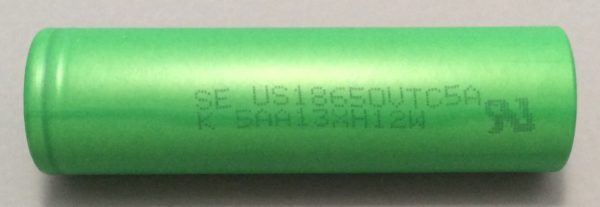
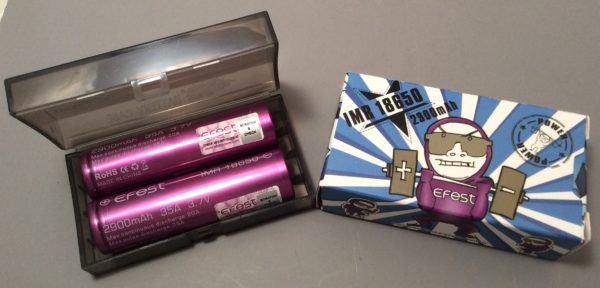
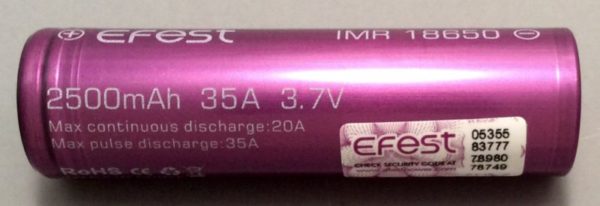










 Store
Store
